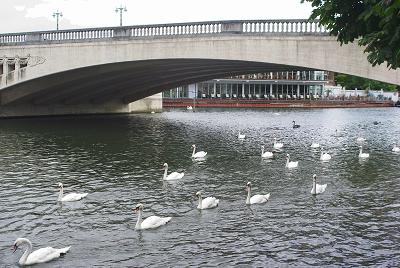William Marshall
 Caversham Bridge
Caversham Bridge
Caversham’s most notable resident was William Marshall. “Who”? I hear you ask.
Marshall was the Mohammad Ali of his day. He was described as the “greatest knight who ever lived” and rose from a relative unknown to become one of the most powerful men in the land.
Born in 1146 William was the younger son of John Marshal, a minor nobleman. During his youth he was sent to Normandy to serve William de Tancarville and begin his training to become a knight. Training was hard, typically consisting of seven years of daily building up his strength and skills with both horses and weapons. The young William was a “natural” and soon discovered that he could make a good living by competing in tournaments.
Contrary to popular opinion tournaments in those days were not relatively mild affairs with two knights on horseback poking lances at each other for the sake of a lady’s handkerchief, but full bloodied staged battles where serious injury and even death were commonplace. Big money could be earned by capturing and ransoming opponents and there was no better practitioner than William Marshall. He was alleged to have competed in over 500 tournaments and was never captured.
Such was his success that Marshall became a medieval celebrity, and attracted much admiration. He soon caught the eye of the King’s son, also known as Henry who was a keen tournament follower. In 1170 the Young Henry appointed Marshall as his personal tutor, which further increased William’s reputation. Marshall stood loyally by his employer through many difficulties during this period, and his reputation continued to flourish. However, in 1182 he was accused of “undue familiarity” with Margeurite of France, who was married to Young Henry. As you can imagine this caused some friction with the King and William was banished from the court.
William Marshall continually petitioned the court of Henry II protesting his innocence and demanding trial by combat. Unsurprisingly there were no takers for this challenge, and he continued to remain in exile from the court. However it was only a few months later when events took a sudden turn. Young Henry became terminally ill and summonsed Marshall to his deathbed. There he asked Marshall to fulfil his vow to go on a crusade. Marshall accepted, and spent the next four years in the Holy Land on Henry’s behalf.
On his return Marshall was allowed to rejoin the court of Henry II and served his King through the many rebellions of the remaining three sons, Richard, Geoffrey and John.
When Henry II died the crown passed to his son Richard the Lionheart. After such a tumultuous period of rebellions the last thing the new King needed was a focus point for yet another dissenting voice, so he approached Marshall and invited him to join his court. This Marshall did, and served Richard with the same energy that he had given to his father.
Richard, in turn, showed his gratitude and in 1189 arranged for William to marry the most eligible heiress in the land, Isabelle de Clare. Isabelle was the daughter of the late Earl of Pembroke, and the title was awarded to William. In addition he was granted the estates of the former Earl, giving him large expanses of England, Wales and Normandy. The former penniless knight had finally arrived.
When John succeeded to the throne in 1199 William offered him his full support. However over the next few years they had some differences and Marshall spent several years on his estates in Ireland, diplomatically keeping out of the way. It was at this time that relations were becoming more strained between the King and the Barons, and it was to William Marshall that King John turned to for help and support over the issue of Magna Carta. So trusting was John towards Marshall that on his deathbed he appointed him to be protector to his nine year old son Henry III, and made him Regent of England to rule while his son was growing up.
Henry really needed the help of William Marshall. The disastrous reign of King John had left the Kingdom in chaos and there were minor rebellions everywhere. Marshall used his military skills and considerable diplomatic tact to keep the dissidents subdued. Marshall kept himself superbly fit, and at the remarkable age of 70 led the charge at the Battle of Lincoln against Prince Louis of France and some disaffected English noblemen. This battle saw the end of the various uprisings, and brought about the peace of 1217.
In 1219 Marshall knew that he was dying and he summonsed the barons and King to his castle at Caversham. The Bishop of Winchester was officially the King’s guardian, but William did not trust him. Ignoring the Bishop’s protestations Marshall entrusted the regency to the Papal Legate until Henry became of age.
His work done, William Marshall died on May 14th 1219. He was buried in the Temple Church in London, where his effigy can still be seen today.
Next Page >